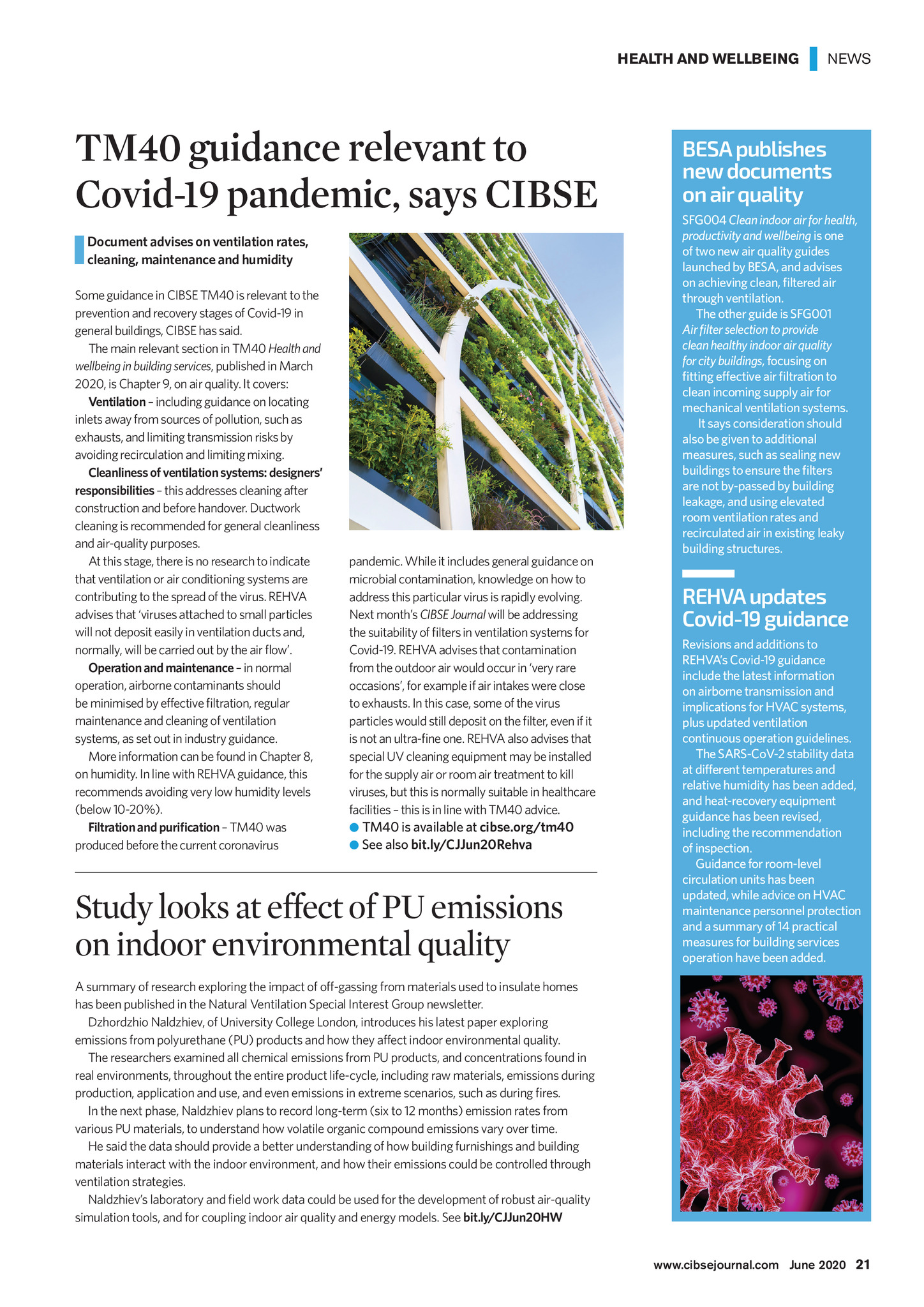


HEALTH AND WELLBEING TM40 guidance relevant to Covid-19 pandemic, says CIBSE Document advises on ventilation rates, cleaning, maintenance and humidity Some guidance in CIBSE TM40 is relevant to the prevention and recovery stages of Covid-19 in general buildings, CIBSE has said. The main relevant section in TM40 Health and wellbeing in building services, published in March 2020, is Chapter 9, on air quality. It covers: Ventilation including guidance on locating inlets away from sources of pollution, such as exhausts, and limiting transmission risks by avoiding recirculation and limiting mixing. Cleanliness of ventilation systems: designers responsibilities this addresses cleaning after construction and before handover. Ductwork cleaning is recommended for general cleanliness and air-quality purposes. At this stage, there is no research to indicate that ventilation or air conditioning systems are contributing to the spread of the virus. REHVA advises that viruses attached to small particles will not deposit easily in ventilation ducts and, normally, will be carried out by the air flow. Operation and maintenance in normal operation, airborne contaminants should be minimised by effective filtration, regular maintenance and cleaning of ventilation systems, as set out in industry guidance. More information can be found in Chapter 8, on humidity. In line with REHVA guidance, this recommends avoiding very low humidity levels (below 10-20%). Filtration and purification TM40 was produced before the current coronavirus pandemic. While it includes general guidance on microbial contamination, knowledge on how to address this particular virus is rapidly evolving. Next months CIBSE Journal will be addressing the suitability of filters in ventilation systems for Covid-19. REHVA advises that contamination from the outdoor air would occur in very rare occasions, for example if air intakes were close to exhausts. In this case, some of the virus particles would still deposit on the filter, even if it is not an ultra-fine one. REHVA also advises that special UV cleaning equipment may be installed for the supply air or room air treatment to kill viruses, but this is normally suitable in healthcare facilities this is in line with TM40 advice. T M40 is available at cibse.org/tm40 S ee also bit.ly/CJJun20Rehva Study looks at effect of PU emissions on indoor environmental quality | NEWS BESA publishes new documents on air quality SFG004 Clean indoor air for health, productivity and wellbeing is one of two new air quality guides launched by BESA, and advises on achieving clean, filtered air through ventilation. The other guide is SFG001 Air filter selection to provide clean healthy indoor air quality for city buildings, focusing on fitting effective air filtration to clean incoming supply air for mechanical ventilation systems. It says consideration should also be given to additional measures, such as sealing new buildings to ensure the filters are not by-passed by building leakage, and using elevated room ventilation rates and recirculated air in existing leaky building structures. REHVA updates Covid-19 guidance Revisions and additions to REHVAs Covid-19 guidance include the latest information on airborne transmission and implications for HVAC systems, plus updated ventilation continuous operation guidelines. The SARS-CoV-2 stability data at different temperatures and relative humidity has been added, and heat-recovery equipment guidance has been revised, including the recommendation of inspection. Guidance for room-level circulation units has been updated, while advice on HVAC maintenance personnel protection and a summary of 14 practical measures for building services operation have been added. A summary of research exploring the impact of off-gassing from materials used to insulate homes has been published in the Natural Ventilation Special Interest Group newsletter. Dzhordzhio Naldzhiev, of University College London, introduces his latest paper exploring emissions from polyurethane (PU) products and how they affect indoor environmental quality. The researchers examined all chemical emissions from PU products, and concentrations found in real environments, throughout the entire product life-cycle, including raw materials, emissions during production, application and use, and even emissions in extreme scenarios, such as during fires. In the next phase, Naldzhiev plans to record long-term (six to 12 months) emission rates from various PU materials, to understand how volatile organic compound emissions vary over time. He said the data should provide a better understanding of how building furnishings and building materials interact with the indoor environment, and how their emissions could be controlled through ventilation strategies. Naldzhievs laboratory and field work data could be used for the development of robust air-quality simulation tools, and for coupling indoor air quality and energy models. See bit.ly/CJJun20HW www.cibsejournal.com June 2020 21 CIBSE_Jun20 pp21 Wellbeing News Supp.indd 21 22/05/2020 17:34